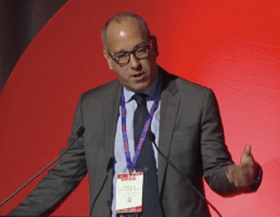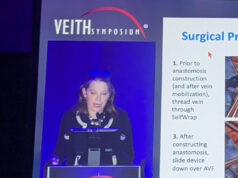
Several subgroups of patients treated with the IN.PACT AV drug-coated balloon (DCB; Medtronic) for arteriovenous fistulas (AVFs) demonstrated a “statistically significant” higher rate of target lesion primary patency (TLPP) compared to those who underwent standard percutaneous transluminal angioplasty (PTA) through 24 months, investigators behind the IN.PACT AV Access study have reported.
Principal investigator Robert Lookstein, executive vice chair in the Department of Diagnostic, Molecular and Interventional Radiology at Mount Sinai Health System in New York, USA, delivered the two-year results from the trial during a late-breaking session at this year’s Vascular InterVentional Advances conference (VIVA; 4–7 October 2021, Las Vegas, USA).
IN.PACT AV is a prospective, global, single-blinded, randomised controlled trial with 330 participants, in which 170 patients received IN.PACT AV DCB and 160 underwent PTA.
The investigators reported that the primary outcome of TLPP—defined as freedom from clinically driven target lesion revascularisation—in patients with restenotic lesions, radiocephalic and brachiocephalic AVF types, cannulation zone lesions as well as anastomotic lesions treated with the DCB through 24 months was superior to those who received PTA treatment in all cases.
“Benefits were seen in all other subgroups, though sample sizes were small and the treatment effect was not statistically significant,” Lookstein told VIVA attendees.
The results showed higher TLPP with DCB vs PTA based on time-to-event analyses: restenotic lesions (46% vs 30.2%), radiocephalic AVFs (53.6% vs 43%), brachiocephalic AVFs (48.5% vs 27.3%), anastomotic lesions (48.4% vs 32.7%), and lesions in the cannulation zone (74.2% vs 18.9%). The greatest TLPP benefit through 24 months was observed in “lesions treated with the smallest balloon diameter sizes”—those treated with balloon diameters of >6mm showed a TLPP of 52.2% in the case of the DCB group vs 38.9% among PTA patients. Meanwhile, lesions tackled using balloons with diameters ≤6mm saw TLPP rates of 52.1% (DCB) vs 32.6% (PTA), the data showed.
“I think this really starts to identify the specific patient population and lesions that are ideally suited for this technology,” Lookstein said. “These durable, long-term data suggest the use of this therapy may be considered standard-of-care for patients with end-stage renal disease [ESRD] at high risk for repeat interventions in their arteriovenous fistulas.”











